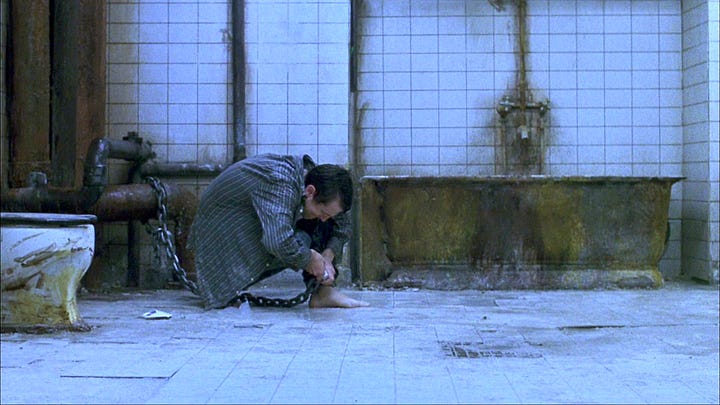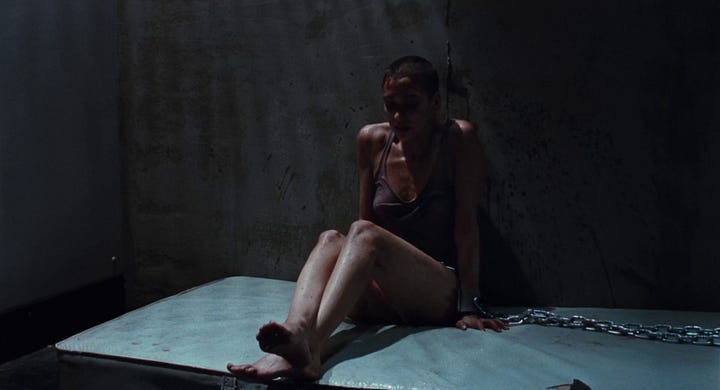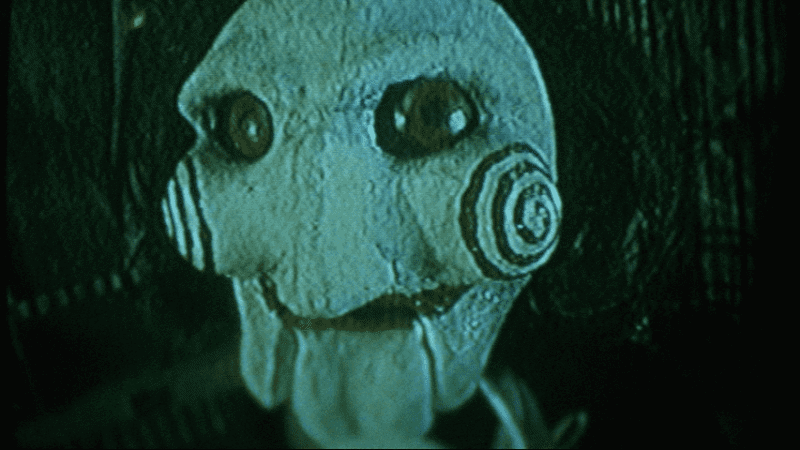Two Film Majors Watch 'Saw' (2004) for the First Time; AKA the Gross-Out Issue
Featuring: vomit sequences, rectal prolapse, the war on terror & more!
Surprise, everyone—I’m still alive!
I know it’s been a while since my last newsletter (and the last time I promised I’d be more active), which was before I started an internship, finished grad school, moved back to Puerto Rico and began the grueling process of searching for career jobs. As I find myself in a period of transience once again, it’s only natural that I bring the blog back. Moving forward, I will try my best to write more regularly—though at this point, I can’t make any promises.
For this Spooky SZN™ edition of Reading From Top to Bottom, I’m joined by my friend Veena Elavarasan. Veena and I met as MFA students at Boston University’s Film and Television Studies program, where we bonded over scary movies and the trauma of writing our Master’s theses. Having since relocated to California and PR respectively, she and I still keep our periodic movie nights alive through FaceTime and Teleparty. A gore fiend who loves B-movies almost as much as she loves caffeinated beverages in colorful aluminum cans, it was Veena’s idea to watch Saw (2004)—which neither of us had seen before—together earlier this month.
As someone with a relatively newfound interest in horror (like many a Gen-Z’er, my infatuation with the genre began with Hereditary only six years ago), I’d been avoiding Saw for the same reason I’ve avoided the Terrifier movies: my threshold for fictional violence is relatively high but not nonexistent, and those films have quite the reputation. Generally speaking however, I’m less put off by gore than I am by, say, human waste, so Saw proved a difficult watch for reasons I did not expect. Instead of relying on extensive carnage to instill anxiety and discomfort in viewers, it grosses us out through other haptic visuals—namely, grime.
This got me thinking about the label of “extreme cinema” and how meaningless it is as a genre moniker, as exemplified by Wikipedia’s classification of it as a horror “subgenre” despite listing of a bunch of non-horror works as “notable films” within that bracket. And what’s “extreme” anyway? Clearly, we all scare differently.
In continuation, Veena and I reflect on our viewing of Saw to discuss real-life gore versus movie gore, what grosses us out the most and which Neopet would most realistically survive a saw trap. If you enjoy this issue of Reading From Top to Bottom, consider subscribing for free by hitting the button below. Happy Halloween!
The following conversation has been edited for length and clarity.
Ursula: Veena, why did you suggest we watch Saw together?
Veena: I'd heard it was—for a lack of better terms—fucked up, but it’s also a classic of the horror genre. You're the only other person I know who can handle stuff like this, because we've seen some crazy shit together, like Antichrist. I assumed if we could handle bad things happening to Willem Dafoe's dick, we can handle Saw.
U: It's funny that you say that, because I knew very little about that movie going in. I knew that it was James Wan's first film, but his work is kind of hit-or-miss for me, (although I maintain that Malignant is a masterpiece everyone should watch). And I knew it was a catalyst for what people now refer to as "torture porn."
V: Same. In the end, it felt more along the lines of Seven, which I have seen and liked, and which has that same visceral, gritty feel to it.
U: Very grimy.
V: I had fun watching Saw, but I just felt so disgusted. My main disgusts in film are gross settings and bodily functions, so that’s what threw me off. Overall, it wasn't as bad as I thought it would be in terms of the violence depicted on screen. A lot of it is implied.
U: Yeah, they cut away from a most of it. The worst part for me was when Adam stuck his hand into the toilet, and it was full of brown gunk.
V: I literally covered the screen with my hands, because that's the type of shit (no pun intended) that I can't take.
U: A lot of times, when it comes to gore, I distract myself by thinking about what must’ve gone into crafting that visual—which is to say it doesn't usually garner much of a reaction from me. But bodily functions are a whole other thing. One movie that made me uncomfortable to the point of experiencing a visceral, almost bodily reaction, was Audition—specifically, the scene where Asami vomits into the dog bowl and feeds it to her prisoner. The toilet scene in Saw gave me similar vibes. What’s the movie moment that grossed you out the most, and how does Saw compare?
V: For me, it's a draw between the bathtub moment in Saltburn, which I still feel nauseous thinking about from time to time, and that scene in Gummo where the kid eats spaghetti in the tub and the water is really black.
U: The one where he drops the candy bar inside the water, then eats it anyway?
V: Yes! That disgusted me a lot more than the toilet scene in Saw. I guess that's my threshold—nasty shit happening in bathtubs.
U: Are you a bath or a shower person?
V: I'm a shower person, because baths gross me out. You just sit in your own stew, marinating.
U: And we use the bathtub every day, so you have to wonder what kind of residue is left on its surfaces.
V: No matter how many times I clean my bathtub, it's still so nasty! That's the thing that throws me off, not gore.
This afternoon, I hung out with a friend who works as a vet tech. We were at a cafe, eating food, and she mentioned that she had a patient come into the clinic—a cute little French bulldog puppy owned by a Nickelodeon star who she doesn't remember the name of. And this puppy is suffering from rectal prolapse.
Rectal prolapse on a dog is gross, but it's not my dog and it's not me. This cannot possibly happen to a human. With a lot of gore, we're far removed in terms of how it's being filmed, who's being directly involved and the likelihood of it happening—that we don't feel as disgusted as we do with something that's so close and intimate to us. But the bathroom's right down the hall.
U: You had an interesting interpretation of Saw as it relates to the time period it was made in.
V: Saw takes place in 2004 and as you know, a few things happened then. The first and most important thing was that was the year I created my Neopets account. But it was also the post-9/11 era, and this film kind of reminded me of the Patriot Act and how people and their civil liberties were at the mercy of government interference. Initially, there was a lot of support for these wars in Afghanistan and Iraq, as well as for torturing people at Guantanamo without due process.
I came to the conclusion that these characters being trapped in a torture chamber, isolated from society, might serve as an allegory for fascism. Like, who gets killed or tortured? Do these people break some kind of moral code? Are they people who engage in transgressive behaviors? The doctor who has an affair and the guy who takes pictures of that—they’re not doing anything illegal, but the things they do can be considered morally wrong.
On the other hand, there are people who are mentally ill or suffer from addiction, like that woman with the head contraption who’s placed in this torture chamber, and who has to prove that she and people like her are worthy of living by passing this series of tests that aren't afforded to people who act "normal." Anyone can be targeted if their behavior is considered transgressive enough in the society that Saw takes place in. And even those who are simply associated with those who transgress these social, moral codes that are in place—like the doctor’s wife and child—are also at risk.
U: I can definitely see where you’re coming from with the idea of the torture chamber acting as an allegory for Guantanamo. Now I’m thinking of the New French Extremity wave, which also started at the turn of the 21st century. I’ve read interpretations of Martyrs that argue it’s about the war on terror—something I’m pretty sure its director has also alluded to in interviews. I think there’s a lot of potential in that visual as a representation of political violence, even in films that don’t entirely qualify as “torture porn” but overlap with the so-called genre—like Oldboy, which revolves around a false imprisonment and takes place in South Korea, not long after the country’s military dictatorship.


V: Do you think we over-braced ourselves for Saw? I was surprised by the lack of dental torture, apart from the woman with the headgear. Usually, dentistry is something that people fear since it involves getting stuff done to a vulnerable part of the body in a very close, intimate environment. This didn’t feature anything like that.
U: Would you watch Saw with your parents?
V: Probably not. My parents liked Seven because they knew who the actors were. With Saw, I think the lack of familiarity with most of the cast probably erases any expectations they'd have, and heighten their disgust, their feelings of disturbance.
U: I'm trying to think of weird things I've gotten away with showing my parents. I think part of the draw for my mom when she tagged along to watch The Substance with me was that Demi Moore is in it, and this has been described as the performance of her career. I feel like my mom would be down for Saw if it starred Denzel.
V: I also think my parents would watch it, if someone like Denzel were in it.
U: To end this conversation on a lighthearted note, which Neopet do you think would be most likely to survive the saw trap in this movie?
V: I think Fyora the Faerie Queen, because she's omnipotent. I'm guessing she could probably get herself out of a lot of these situations, because she has unlimited power. She's like the god of Neopets, because she controls and dictates everything.
U: You don't think she would get to the point Cary Elwes’ character got to, where he became so desperate to escape that he amputated his foot?
V: Maybe she would, because it could grow back with magic. But that is true of all faeries—except the water faerie, who needs water or she'll die. ■





